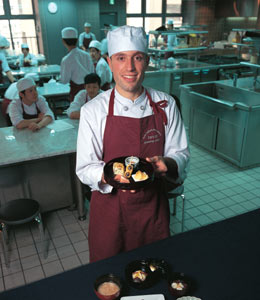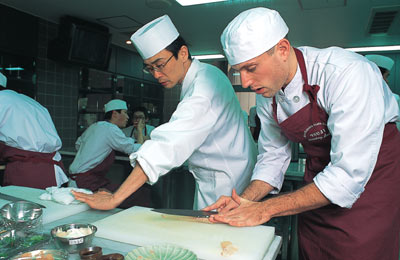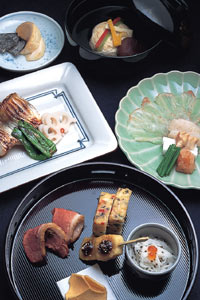| Web Japan > NIPPONIA No.36 > Living in Japan |
|
|
|
NIPPONIA No.36 March 15, 2006 |
|
Living in Japan
Studying Japanese Cuisine:
It Takes a Good Cutting Hand and a Taste for Culture Avi Yadin Sternberg
Written by Takahashi Hidemine
Photos by Akagi Koichi
|
 |
Ecole Tsuji Osaka teaches cooking and confectionary making, and young people keen on becoming professional chefs go there from all over Japan to learn. The school is in Osaka's Abeno Ward, and one of the students learning Japanese cuisine there is a 27-year-old American from Denver, Avi Yadin Sternberg.
“Japanese cuisine requires attention to detail. You're not just preparing a meal—you're cooking from the heart,” says Sternberg in fluent Japanese, as he cuts through a fish.
In high school he decided to become a chef some day, and he worked part time in different kinds of restaurants while continuing his studies. His first experience with Japanese food was during his third year at university, when his parents happened to take him to a sushi bar.
“I was amazed watching the chef. His knife dealt with the fish like lightning. Every motion was smooth, geared to pure efficiency. I felt that something fundamental was different—food is not prepared like that in other countries.”
He made up his mind and acted right away. He took a leave of absence from university and arrived in Japan at the age of 21. Before long, an acquaintance helped him apprentice at a traditional restaurant in Yamagata Prefecture. But his knowledge of Japanese and the culture was minimal and this made communication next to impossible.
“They were trying to show me the ropes but I couldn't understand and kept making mistakes, even with simple things.”
So the obvious step was first to study Japanese properly. He moved to Osaka and spent a year learning the language at the YMCA there. After that, he found himself at Ecole Tsuji Osaka. The first lessons were just what he wanted—how to manipulate a knife. One technique was katsura-muki, turning a large daikon radish round and round while cutting off the peel really thin. Practice and more careful practice, until he mastered the art of cutting food the Japanese way.
“Watching the teacher and doing it yourself are quite different. Picking up the techniques starts with the basics. You learn one thing and build on it. That requires patience. In the end I realized that if you're patient you can concentrate, and if you can concentrate you can relax, which means you have the potential to move like a professional chef, with 100% efficiency.”
He was also fascinated by the many ways Japanese cuisine reflects the season. Just two examples are ice setting off a meal in summer, and citron cut into slices like pine needles, then placed on top of food as a decoration in winter. “Every dish has some meaning—amazing, isn't it?”
His teachers find him always ready to learn. When they show him something, he is bound to ask why it is done that way. Says one of his teachers, Hashimoto Nobukatsu, “He asks me why, and that sometimes gets me thinking... good question!” It seems that teaching can be a two-way street.
On his days off, Sternberg is likely to go to a pottery exhibition to learn about tableware, or to study ikebana flower arrangement or Japanese calligraphy to get ideas on arranging food for the table.
“After I graduate, I want to work at a traditional restaurant here in Japan. I want to learn as much as I can, then some day, teach authentic Japanese cuisine in the United States or Canada.”
That is why, he says, he always tries to pay attention to detail when studying. Cooking comes from the heart. And when the heart is eager, traditions are easily passed on to another generation of students.
|
 |
|
Sternberg tries his hand at the usu-zukuri (extra-thin slicing) technique, guided by one of his teachers, Hashimoto Nobukatsu (standing next to him). They are practicing on a flatfish.
|
|
